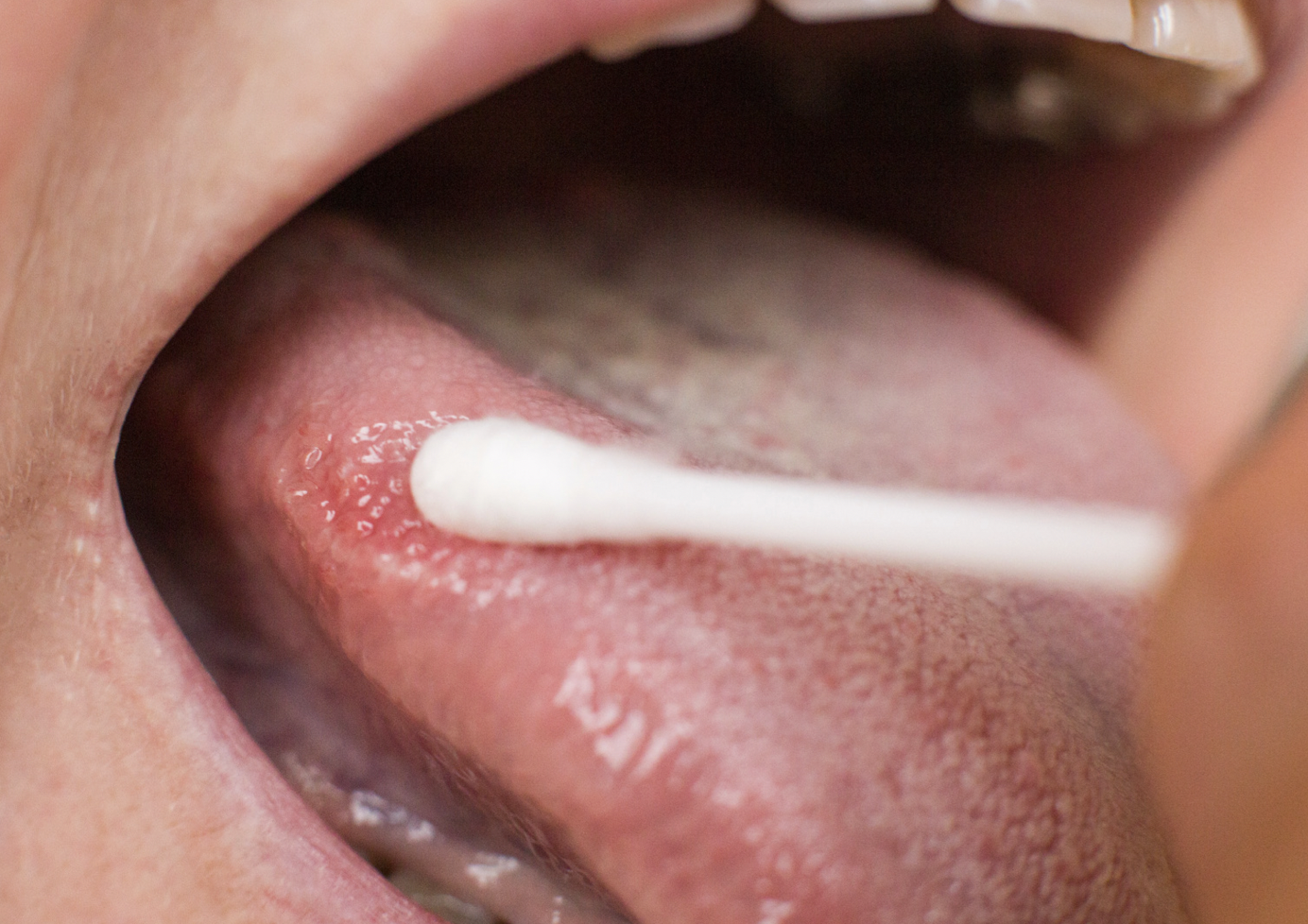Definition
Leukoplakia is a thick patch of plaque that appears white or gray on the gums, lower part of the mouth, mouth wall, and sometimes on the tongue. This thick patch cannot be cleaned or removed. Leukoplakia differs from mouth ulcers because it can be an initial form of oral cancer (pre-cancerous lesion). Over 15 years, approximately 3 to 17.5% of individuals with leukoplakia may develop into squamous cell carcinoma.
There are several types of leukoplakia, including:
- Homogeneous Leukoplakia: Uniform in color and surface across all its parts. Most of it is white with a smooth or serrated surface.
- Non-homogeneous Leukoplakia: It is white or white with red spots, has an uneven surface, is protruding, or is serrated. The presence of wounds (ulcers) or lumps (nodes) on leukoplakia can indicate the possibility of it developing into cancer. Non-homogeneous leukoplakia has a seven times higher risk of progressing into cancer.
- Oral Hairy Leukoplakia: Caused by Epstein-Barr virus infection in the mouth. Individuals with compromised immune systems, such as those with HIV/AIDS, can develop oral hairy leukoplakia. This leukoplakia appears as a patch with white, hair-like growth. While oral hairy leukoplakia cannot develop into cancer, it serves as a sign of immunocompromised health.
Causes
The causes of leukoplakia are still not fully understood. Still, it is presumed that continuous irritation in the mouth, particularly from tobacco use (whether through smoking or chewing), can lead to leukoplakia. Regular use of chewing tobacco may result in leukoplakia on the cheek, as it is more frequently in contact with the tobacco. Other factors contributing to chronic irritation in the mouth include:
- Broken teeth with sharp surfaces that can frequently wound the tongue.
- Broken or ill-fitting false teeth.
- Long-term alcohol use.
- Biting the sides of the mouth.
Hairy leukoplakia is caused by the Epstein-Barr virus (EBV). Once infected, the virus can remain in the body for the long term. Normally, the virus remains dormant, but if the immune system is weakened or compromised, especially by conditions like HIV/AIDS, the virus can be reactivated, leading to the development of hairy leukoplakia.
Risk factor
Risk factors that can increase the likelihood of developing leukoplakia include:
- Male gender
- Age between 5 and 70
- Long-term tobacco use, whether through smoking or chewing
- Chewing areca nut (betel nut), commonly found in Asia, the Pacific, or East Africa
- Long-term alcohol use
Risk factors that can increase the likelihood of leukoplakia becoming malignant include:
- Female gender
- Long-term presence of leukoplakia
- Presence of leukoplakia in non-smokers
- Location on the tongue or lower part of the mouth
- Size exceeding 200 mm
- Non-homogeneous leukoplakia
- Epithelial dysplasia or abnormal growth of epithelial cells
Symptoms
Symptoms of leukoplakia include:
- There are one or more white patches on the surface of the tongue, lower part of the mouth, mouth wall, or cheek
- Patches that cannot be removed or cleaned
- Patches are not accompanied by pain or other symptoms unless they have progressed into oral cancer
- Variation in patch color, ranging from white to white with red spots
- Red spotting can be an initial sign of cancer
In several cases of leukoplakia in females, white patches may also appear on the genitals. This typically occurs in women who have reached menopause.
Diagnosis
To establish a diagnosis of leukoplakia, the doctor will generally:
- Examine the white plaque in the mouth
- Attempt to remove or clean the plaque
- Inquire about risk factors and medical history
- Exclude other causes that can result in similar white plaques
If leukoplakia is suspected, the doctor will ensure that the plaque is not an initial sign of cancer through diagnostic examinations such as:
- Oral brush biopsy: This procedure involves taking tissue from the mouth surface using a cleaning brush. While non-invasive, it may not always provide a definitive diagnostic result.
- Excision biopsy: Tissue is taken from the white plaque or the entire plaque if it is small. Excision biopsy tends to offer more reliable results than oral brush biopsy.
If the biopsy results indicate malignancy, the doctor may attempt to remove the entire plaque, and further treatment may not be necessary. However, if the plaque is large or extensive, referral to an Ear, Nose, and Throat (ENT) specialist for additional examination may be recommended.
Management
The treatment of leukoplakia tends to yield better results when initiated early, even if the lesion is still small. Further examination after plaque removal is recommended.
In many cases, reducing the causes of irritation, such as tobacco and alcohol consumption, can help alleviate leukoplakia. However, if these measures prove ineffective and there are signs of potential oral cancer, the treatment plan may include:
- Leukoplakia removal: This can be done using a scalpel, laser, or cryoprobe.
- Routine examination: After removal, routine check-ups for oral health are essential, as leukoplakia may recur.
Oral hairy leukoplakia generally does not require specific treatment. However, if recommended, the doctor may prescribe antiviral drugs and advise routine check-ups.
Complications
Leukoplakia generally does not cause direct damage to the mouth, but it does increase the risk of oral cancer. Oral cancer often develops in proximity to leukoplakia plaques, and these plaques can undergo changes indicating malignancy. Even after removal, the risk of oral cancer remains elevated. Consuming foods rich in antioxidants, such as spinach and carrots, may help prevent the irritation that leads to leukoplakia.
Prevention
To prevent leukoplakia, it is important to avoid or reduce the consumption of tobacco and alcohol products. Seek guidance on methods to help reduce these habits. If you still engage in smoking, chewing tobacco, or alcohol consumption, it is advisable to undergo routine oral health checks with a dentist. Oral cancer rarely shows symptoms in its initial stages, and manifestations typically become apparent in later stages. The most effective prevention strategy is to cease the consumption of tobacco and alcohol.
For immunocompromised individuals, such as those using steroids or living with HIV/AIDS, preventing oral hairy leukoplakia may be challenging. However, early detection can contribute to a faster recovery process.
When to see a doctor?
Leukoplakia rarely causes discomfort, but it can be an early sign of a more serious condition. Consult a doctor or dentist if you experience:
- White plaques or mouth ulcers that do not heal for at least 2 weeks.
- White plaques with red spots in the mouth.
- Persistent changes in mouth tissue.
- Ear pain while swallowing.
- Increased difficulty in opening the mouth.
- dr Nadia Opmalina
Mayo Clinic Staff. (2018). Leukoplakia. MayoClinic. Available from: https://www.mayoclinic.org/diseases-conditions/leukoplakia/symptoms-causes/syc-20354405
Cleveland Clinic Staff. (2020). Leukoplakia. Cleveland Clinic. Available from: https://my.clevelandclinic.org/health/diseases/17655-leukoplakia
Luo E. (2019). Leukoplakia: Causes, Symptoms, and Diagnosis. Healthline. Available from: https://www.healthline.com/health/leukoplakia
Mohammed F, Fairozekhan AT. Oral Leukoplakia. [Updated 2021 Jul 27]. In: StatPearls [Internet]. Treasure Island (FL): StatPearls Publishing; 2022 Jan-. Available from: https://www.ncbi.nlm.nih.gov/books/NBK442013/
Huizen J. (2019). What to know about leukoplakia. MedicalNewsToday. Available from: https://www.medicalnewstoday.com/articles/317689












